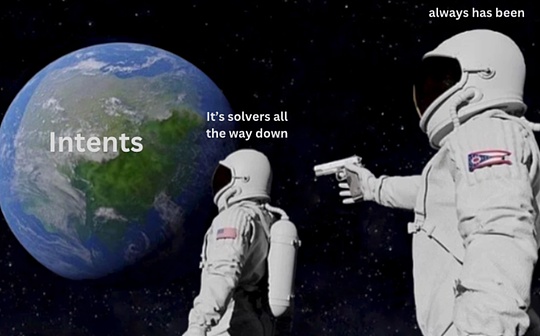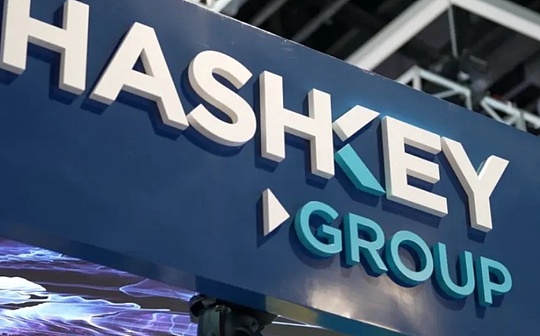
Author: Arjun Chand Source: li.fi Translation: Shan Ouba, Bitchain Vision Realm
Although the intention -based bridge can speed up the bridge to connect the UX, they may become a centralized solution due to the lack of solution.
The lack of solving the user’s intention is a well -known issue.This is a recognized question,The solution sounds simple -just add more solutions -but it has not yet been resolved.
We realize that the realization of intention is inseparable from the resolution.We need to solve this unreasonable problem, that is, the introduction of more solvers, otherwise, we may face extremely similar risks of the financial industry and the traditional financial industry -the order flow is concentrated in the hands of a few entities.
In this article, we define the structure of an agreement -based agreement and explore the emerging solutions in the market. These solutions can solve the problem of the shortage of solution by solving the pain point of the solution to solve the solution.
Intention
It intends to subvert the way of transaction operation and focus on the ultimate goals or “intent” of users, rather than the specific steps to achieve the goals (will be introduced in detail later).There are two main benefits based on intention design:
-
User experience -seamless connection with user experience, usually fast.Users express their intentions, and the rest are handled by the solution device.GAS abstraction and other functions make experiences smoother than ordinary transactions.Instant (JIT) liquidity means that trading does not need to wait for a few minutes.Overall, the experience based on intention is not so cherished for users, and most of the web2 applications can give users a “one -click” feeling.
-
Executive efficiency -Solution provider is usually a professional municipal business or agreement team and is responsible for handling transactions for users.The argument here is that, compared with the basic AMM contracts or end users of multiple applications navigation, professional solution providers are more capable of building transactions to achieve the best chain execution.Other functions such as transaction batch processing and order match make the intention to implement more capital efficiency.For users: no longer stupid mistakes, waste resources, and frustrating chain experience.For applications: no longer rely on simple and low -efficiency contracts to achieve complex trading paths.For LP, there is no potential liquidity staying in the old chain contract.
The design based on the intention is the core of the birth bag of “chain abstraction” — that is, to build an application that interacts with multiple chains, and at the same time, it feels like a single, interconnected “encryption” experience.
With intention, everything is solved
There are three main parts based on intentional agreements:
-
Intent expression -the result of the user specifies the expectations on the application.For example, on the bridge, users may say that they want to use 1 ETH on the 1 Eth on Arbitrum 1 ETH.
-
Interested execution -the auctioneer determines the most effective way to execute the user’s intention through the auction.The winner (such as the relay in Across) will meet the request (send 1 ETH to users on Optimism).
-
Intent settlement -resolutioners have received compensation due to their services (for example, receiving users’ 1 ETH + small amount of users on Arbitrum).The intention agreement proves that the intention is satisfied.However, this is just one aspect of settlement.The biggest picture is that the intention settlement also promotes the reconstruction of the resolution of the capital between chain and assets.
>
Good intentions -fluency, fast, efficient, simple.But there is a problem based on intent: lack of solutions.
The root of intention centralization
The solution device is the pillar of the intention -based protocol.They are entities that actually execute user intentions, such as delivering assets from Chain B to Chain A.
Ideally, the solvers are a competitive environment, and the solvers are scrambling to achieve intention at the lowest price.However, it is difficult to be a solution.However, the solution has a certain threshold for entry:
-
Pledge requirements -some intentional protocols have pledge requirements for solvers participating in order flow auctions.For example, in the 1Inch Fusion, the top 10 solvers (referred to as parsers) are allowed to participate in the auction.These solvers rank and include a whitelist based on their “unicorn power”. This is an indicator determined by the 1INCH tokens (by the solution itself or representative) and the pledge period.The existence of these pledge requirements is to prevent malicious behavior, which is a good thing.what is the problem?These pledge may be a major barriers to enter, especially for small players who may not have previous capital.
-
License system -many intentional agreements are licensed, which means that they have the doorkeeper to decide who can participate.For example, in the case of 1Inch Fusion, access permissions are based on the power of unicorn, and in other systems such as Uniswapx Beta, participation may be included in the whitelist that may need to be auctioned.These systems give priority to the quality of implementation to ensure that only the reliable solution device allows participation.This method helps the agreement with a smooth and trustworthy user experience, allowing users to be confident in the quality of execution.However, although the nature of the permit has its own benefits, it also limits the broader solution to the auction.
-
The cost of complexity -the solution needs to be continuously re -balanced to achieve cross -chain intention.In addition, the number of chains is growing, which makes it difficult for the solution to maintain cross -chain inventory, re -balance and hold the correct assets in the ecosystem, because L3 may be popular overnight, or L2 may rise at a time and decide when it rises.closure.There are also fragile problems.The intention -based agreement is a relatively new solution in the market, and it continues to develop with the emergence of new margins.This requires the frequent update of the device, which increases a layer of complexity.
-
High fixed costs -writing complex code, management of custom integration of each intentional agreement, maintaining cross -chain asset inventory, processing RPC cost, and maintaining special hardware to win the speed contest — these just add another to the solution device to add another anotherSome obstacles to layer complexity and costs.
-
Inspiration and lack of order flow -as a rational participant, the participation of the solutors is not for charity.They need to see investment returns to prove that their participation is reasonable.Affordable (such as cost, complexity, and funds involved) should get higher returns.Otherwise, the expected value may not be enough to prove that the effort paid is reasonable.At present, there are few applications in the intention area that has sufficient order flow, which is enough to make the resolved effort (think of the quantity and potential profitability and the trouble of integration).This is why the applications (1Inch, COWSWAP, UNISWAPX, and Across) have seen sufficient solutor’s participation and competition, but other applications are difficult to attract enough solutions due to low order flow.
Therefore, today, we found that the participation of top minority applications and a wider ecosystem’s solving device formed a sharp contrast.
For example, let’s take a look at the two benchmarks of the intention -based protocol: COWSWAP used to exchange intentions and ACross for cross -chain intent:
COWSWAP has 16 independent solvers that compete for user orders.No solution can take the lead, and no solution is operated by the COWSWAP team.
Across has more than 15 solver (referred to as relayrs) to actively compete to meet the user’s cross -chain intention.Although Risk Labs continues to run its own solution, the following figure shows that there is no solution device that can lead the auction as the early data in our research.There are sufficient competition between the solution.
>
Order flow distribution between cross -relay.Note: The solution device represented by the green and dark gray in RISK LABS operation.
At the same time, most of the intentions based on intent are solving the solution. These solutions are either a strong capital businessman or the agreement team itself (they have vested benefits for the user’s intention to execute on their applications).
There are many reasons for this difference, but in the final analysis, there is no sufficient solution.This seems to be a small detail, but it is actually a centralized timing bomb.
What is worrying is that the lack of solvers can cause centralization.This means the possibility of single -point failure, censorship risk, and the increase in the cost of the solution.
This is not the openness of the openness we envisioned, the future of no license, right?We basically install a fancy user interface on the centralized system -this is the opposite of the entire open financial revolution, and we have made the same error as the leftover system we want to subvert.
We need to solve the bottleneck of this solution as soon as possible.To launch more solutions as soon as possible is the key to release the real potential of the intention -based system.
The good news is that the situation shows signs of improvement.The new project is starting, and the existing team is cooperating to make more solutions easier to join.
In the next section, we will explore some new solutions in depth, aiming to make the solution device in each step of the system -based system easier to work.The more the solution device, the more fun, right?
>
Standardized Institutional expression-ERC-7683
The intention -based agreement does not clearly collect the user’s intent and broadcast it to the solveser.This means that each application -based application creates its own workflow and framework to determine what information should contain and how to deal with this information.
The lack of standardization means that solutor personnel need to do more to be familiar with the working principle of each intention -based agreement (people may think that the phenomenon of fragmentation will intensify).Solutions must spend time and resources to understand each specific system and write custom code to support it.
As the number of intentional agreements in the market continues to increase, this method is no longer sustainable for solutions.Fragmentation causes the solution network of each application to be isolated from each other and weakens the Internet effect flywheel that weakens the intention, because we continue to build in our wall garden.
To solve these problems, Uniswap Labs and Across propose ERC-7683, which is a standardized format for cross-chain intent.This standard provides several benefits:
-
Simplify the integrated-solving device to only understand one format to achieve any intention that meets ERC-7683.This greatly reduces the entry threshold of the new solution.
-
The universal network of existing solutions -applications can access the pre -existing solution network without constructing and maintaining their own network.This also increases the competition between the solution device to achieve intentions, which may reduce the cost of user.
>
Many infrastructure protocols (such as Khalani, Nomial) based on the solution device are aimed at compatible with ERC-7683.This is a promising development that represents the win -win situation of all stakeholders -UNISWAPX and other intentions based on intention.Get more order flow from the first day.
There are several great benefits of this compatibility:
-
No need to build your own solution network to launch new intentional agreements.This is similar to the benefits of EIGENLAYER, which allows projects to rent the economic security of the project.
-
Solution providers will have the opportunity to compete for order flow in a larger global market, rather than limited to smaller local markets, because these markets do not have sufficient incentive measures to attract more solutions provider to join.
However, ERC-7683 also has some potential shortcomings and restrictions, which may hinder its overall advantages and adoption:
-
The possibility of competition standards -the problem of standards is that it is difficult to manage the incentive mechanism between all participants in the ecosystem.Unless the chain itself embeds the standard at the level level, people will question whether it really becomes a public product that benefits everyone equally.As far as ERC-7683 is concerned, it can be said that Across and UNISWAP will obtain more benefits from the use of this standard, whether it is a marketing perspective or an early use of the definition standard.We have seen similar bridge standard obstacles in the past. For example, the XERC-20 standard related to the Connext brand or the OFT standards related to Layerzero Labs all illustrate similar obstacles.Despite the efforts to define standards as credible neutrality, people still doubt whether they have obtained unsuitable benefits in some aspects.This suspicion often leads to competitive standards, thereby destroying the purpose of establishing a unified standard.
>
The standard problem is that there will be multiple.
-
In fact, the dynamics of the solution device may worsen-ERC-7683 needs to ensure the creation of a fair competitive environment, so that the new and old-fashioned solutions can compete fairly.If the standard eventually creates a market dynamics, so that the more powerful solution device like Wintermute finally won most of the order flow, then people must question whether it is really good.
-
This standard only covers the Ethereum and EVM ecosystems -intended applications are not limited to Ethereum and a wider EVM ecosystem.Today, Solana’s daily and monthly transactions have been higher than Ethereum and its L2.It is necessary to consider that the standard chain has nothing to do with the ecosystem and the blockchain, although this will make the coordination more difficult.
-
This standard only covers cross-chain transfer and price-limited orders-ERC-7683 mainly revolves around cross-chain intent.This kind of attention may limit its applicability of other forms of intent, thereby limiting the effectiveness of its wider use cases in an intentional agreement ecosystem.However, it is important to consider the argument of ACross: they believe that most cross -chain operations will be simple transfers, not complex multi -step operations.These operations usually involve initial cross -chain transfer, and then further execute on the target chain.In essence, this standard caters to the most common cross -chain case: transfer.Moreover, it can be used with single -chain operations to achieve various intentions, rather than the standard itself covers possible intention.
Solving device collaborations for execution -Khalani and other platforms
Most of the intention -based protocols are concentrated in the narrow range of the limited number of chains, such as exchange and bridge.
To truly become the leading design architecture, the system based on intention needs to surpass exchange and bridges to support wider operations, including pledge, lending, and legal currency access.
One way to support more types of intent is to hire special solutors.By hiring solutors dedicated to these specific fields, we can ensure that each intention is executed at the highest degree of proficiency, so as to obtain more optimized results.
These specialized solvers must work together instead of working in isolation.This collaboration will allow more universal intentions based on the intention of intention, combined with multiple operations to achieve wider intentions.
Khalani and other platforms have proposed a solution to achieve collaboration between the solution.The solution device no longer competes with each other, but work together to find the best solution for each user’s intention.This enables many smaller and professional solutions to effectively collaborate.
>
As Kevin Wang (co-founder of Khalani) described: Khalani is a platform for the point-to-point solution “Coincidence of Can-DO”.Collaboration can decompose complicated intentions into smaller special intentions (or combined intentions), which are more easy to manage for single solutions.
Khalani provides a platform that allows the solution to combine their resources and professional skills to solve specific user intentions more effectively.It can be imagined to create a “solution pool” similar to the pledge pool -by gathering their resources, participants can get more consistent and higher results than themselves.
In order to understand how Khalani achieves the collaboration between the solution and the solution device, we will consider an example.
Assuming … Bob is an Ethereum user with USDC. He wants to use ETH on Arbitrum and use intention -based bridges.
The solution device can use Khalani to implement this intention as follows:
1. Bob submits his intention: “I want to use ETH on Arbitrum to exchange USDC on Ethereum.”
2. Select an exclusive solution device based on the intention of the intention to meet the intention of BOB. We call this solution device A -select the determined solution device.
However, the inventory of the solution A on Arbitrum is not enough to meet the intention of BOB, so it is decided to use the Khalani’s solution pool to provide the required funds.
3. Solving device A sends the intention to Khalani to ask another solution device (or a combination of solution device) to prepare funds on Arbitrum in exchange for Bob’s lock -up funds on Ethereum.
4. Another solution device, the solution device B (ARBITRUM whale) holds inventory on Arbitrum and provides the required assets to the BOB on Arbitrum.
5. User -Settler settlement -Once the solution B completes the BOB request, the solution A will settle the settlement platform with the user to settle with the user. In this example, the settlement platform is a bridge based on intent.Therefore, the solution A receives the BOB USDC on Ethereum.
6. Solving device -Solving device settlement -Solving device A to settle the execution certificate with the Khalani chain and settlement of the solution device B.
Although this is a simplified example that explains how to cooperate on Khalani’s cooperation to achieve intentions, Khalani can use the same process to execute more complicated intentions.
For example, Ethereum user Bob, which has USDC, wants to deposit ETH into the lending platform on Arbitrum.
In this case, the selected solution device can cooperate with multiple professional solving deities on Khalani, depending on the required professional knowledge:
-
Solution A (Price Expert) -The most accurate price of the same chain or cross -chain transaction is found.It can be used for USDC / ETH liquidity according to the information on the chain and under the chain.
-
Solution B (Arbitrum whale) -holding inventory on Arbitrum, which can be used for ETH required for pre -deposit on Arbitrum.
-
Solver C (Ethereum actuator) -the best execution on Ethereum, providing users with price/delay balance as options.It can be used to perform transactions to obtain user deposits on Ethereum.
-
Solver D (Arbitrum actuator) -The is specially used to execute transactions on Arbitrum.It can be used to perform local transactions and store ETH into the lending platform on Arbitrum.
Similarly, other special solutions on Khalani can also be called, and the complex intention is decomposed into a simplified task performed by the combination of the solution device, instead of relying on a single solution device to complete all jobs.
>
The implementation of universal intent can be achieved through Khalani, which will be a huge breakthrough for paradigm based on intent.However, every step of this process has potential bottlenecks, which may affect the execution of intention:
-
When submitting the intention, the user error appears -if the application interface design is used to collect specific intentions (such as exchange or bridge), the scope of the user’s error will be limited because the user will follow some criteria when submitting the intent.However, the interface designed to collect universal intentions may be more challenging and prone to user errors, because users may submit incorrect or incomplete intentions, resulting in failure or incorrectness of intent.
-
Activity risk -there is a risk of activity for the intent system, that is, the unavailable solution cannot be used, which may cause the entire system to stagnate.In addition, the solution may not be able to perform the task correctly or in a timely manner, resulting in the failure of the transaction.
-
The availability of a limited solution — the number of solutions available for different types of intentions in Khalani infrastructure may be limited.This will reduce the possibility and overall efficiency of intentional execution.
-
Solution-the complexity of the solution device-coordinated multiple solution device may be complicated and easy to make errors, because many changes are involved, such as the availability, market conditions of the special solution, and the factors related to the intention itself, suchThe chain, the scale of capital required, etc.
-
Risks related to intention atoms -all the operations of all solveers are atoms and execute together on the Khalani chain.This means that the solution experiences atomicity on Khalani, that is, all parts of the process are either successful in a single operation or all success.If any part of the transaction fails, the entire transaction will roll back, which may lead to a high failure rate.However, there is no risk of funding or loss of funds here.
-
The collaboration of the solution to the solution increases the delay -although the collaboration is found to be under the chain and it is almost instant, it will increase some delays due to the following factors:
1) Task dependence: certain tasks may depend on the completion of other tasks.Coordinating these dependencies and processing errors may cause delays, because the solving device needs to wait for the prerequisite task to complete.
2) Safety and verification steps: Implementing safety inspections and other steps to verify transactions to prevent fraud or malicious behaviors that may increase delays.
Despite these potential delays, in order to ensure the reliability and overall quality of the intention of the intention, some intentional agreements will run permit auction, and choose to work with the trusted solution device and whitelist.
However, it must be noted that this delay depends on the task, and if the task is performed by a single solution or multiple solution device, it will not changeIt will be similar.
ERC 7683 x Khalani flywheel
The solution device basic platform will be compatible with ERC-7683 and other standards, because it is a win-win situation for all participants.The main goal of all these projects and plans is to allow more solutions in the ecosystem. If we can do this, the compatibility between the two can start the flywheel effect for a paradigm based on intent:
>
-
More solutions -As the number of solutions increases, it is possible to implement more types of intention.
-
More solutions collaboration -with the emergence of more professional solutions, collaboration opportunities have increased.Solutions can solve more complicated problems in combination with their professional skills.
-
Intent ability is stronger -the cooperation between solutions is enhanced, and more expressive and more complex user intentions can be performed.Users can request more complicated operations that need multiple steps and professional knowledge.
-
A general standard is needed -as the expressiveness of intention continues to increase, it is necessary to establish a general standard for applications based on intent to ensure that the solution device can be simply inserted into a general interface and collecting intentions from different applications.
Capital efficient intention settlement -clearing layer like Everclear
During the settlement process, the solvers were repaid on the source chain that generates the user’s intention.This means that they eventually scattered funds on more than a dozen different chains, and they need to continuously reconnect these chains.This is not only troublesome to manage, but also many funds are just idle as assets.In addition, the more chain, the weaker the liquidity of each solvener over time.
At present, there is no shared system to coordinate the capital flow between blockchain.Each solution provider is a lone wolf, managing liquidity in this fragmented chaos.This is where Everclear aims to intervene and solve the problem of a solution provider.
Everclear aims to solve this problem by coordinating the global liquid settlement between the “liquidation layer” -the clearing layer is a decentralized network that coordinates the global net set of capital flows between capital flows.
The key to Everclear value claim is the concept of net settlement.
The net settlement is a mechanism that summarizes multiple payments (or mergers) of different parties to reduce net payment (or the number of payments).This means that the net settlement is not to handle each transaction separately, but to calculate the total arrears between the two parties, and then pay only the difference.This makes the process easier and reduces the number of payments required.
>
For those who belong to the cryptocurrency nomadic club, you must be familiar with Splitwise -this is an application that helps a group of people to track and share fees (such as during travel).The “settlement” function in Splitwise is a perfect net settlement example:
-
Tracking cost -each member in the group records their costs into the application.
-
Calculate the balance -Splitwise calculates each person’s arrears or the amount should be obtained.
-
Clear (net settlement) -Splitwise does not allow everyone to pay the other party multiple times, but will calculate the simplest way to solve all debts.
Remittance companies such as Transferwise also adopted the concept of net settlement.They are not cross -border transfer funds, but to match the currency demand and the contributor to match, and then settle each other.This reduces the number of transfers that actual needs, making it more efficient and cost -effective.
Similarly, Everclear allows solvers to “settle” cross -chain, thereby greatly reducing the total number of settlement required, thereby minimizing the cost and inventory and overall complexity of the solution.For those who understand the principle of COWSWAP work, the essential net settlement is the large -scale meetings of the solutor to meet the needs on a large scale between the solution.
>
Everclear believes that about 80% of the capital flow of the blockchain every day can achieve net settlement.This means that with an average of $ 1 every day a day, $ 0.80 will be transferred out.This means that in general, the transaction volume sent through the bridge is 5 times that of the necessary amount, and because the solution is working independently, they are more balanced between the blockchain.
Let’s try to understand how users (intention -based protocols, solutions, or CEX) use Everclear’s stack.
Taking Alice as an example, she is a solver who tends to settle on Arbitrum.Alice needs to fill in a 10 ETH transaction from Optimism to Arbitrum.The following is the operation method of using and not using Everclear:
>
We can see that the liquidation layer like Everclear is for users like Alice (solution, MM)::
-
Settlement preferences -Lice tends to settlement on Arbitrum, and Everclear ensures that she is repaid on Arbitrum, which is consistent with her preference.
-
No need to reconnect -if there is no Everclear, Alice needs to receive 10 ETH from the Optimism Bridge to Arbitrum to reconnect.With Everclear, this step saves time and resources.With Everclear processing re -balance, the entire workflow becomes simpler.This may be particularly attractive for new entrants to join the solution pool.
-
Reduction of operating expenses -by eliminating the needs of manual re -balance, Everclear reduced Alice’s operating expenses, so that she could focus on solving more transactions.
-
Save cost -Avoiding funding bridges between chains can save trading costs and potential slide points, making this process more cost -effective for Alice.This can also bring more consistent jobs and higher income to the solvers.
By eliminating the main pain points of the solution provider, Everclear can inspire more people to participate in the ecosystem, and ultimately help generate the flywheel effect that attracts more solutions providers.
Everclear is located in the intention stack, so any protocol or infrastructure involved in the solution device can use it to solve the problem of re -balance and reduce the cost and operation complexity of the solution device.
For example, solutions such as Khalani and other solutions will be integrated with Everclear, so that solutions through its stack collaboration can use Everclear to achieve efficient capital settlement.Therefore, it can be said that the launch of Everclear is a positive development for paradigm based on intent, because it improves all different types of projects belonging to this ecosystem and expands the market for everyone.
To achieve this, “Everclear is designed as Arbitrum Orbit in cooperation with Gelato RaaS”.At the time of the Alpha main network (scheduled to be early in the third quarter of 2024), Everclear will be restricted and protected by some restrictions:
-
License assets and chain support -Initially, only the allowable list chain and assets are supported, which limits the openness and availability of the system.However, there is no permission to implement in the future.
-
Relying on EigenLayer -Everclear to rely on Eigenlayer to achieve security, but it does not support cutting.This limits economic security until it is implemented.Users must believe that EIGENLAYER will implement cutting to enhance economic security in the future.However, before reducing implementation, Everclear plans to use Hyperlane’s verification device set to ensure security.
-
Everclear will launch an upgraded smart contract -although upgraded contracts are flexible, but if they are not managed properly, they will also bring risks, such as vulnerabilities that may occur during the upgrade.
Note: Alpha main network is similar to the public test network stage of Everclear.Fully release will be characterized by the expansion of no right to limit chain, allowing the chain to define its own security preferences.
In addition, Everclear has some potential risks and trust assumptions as a clearing mechanism:
-
System failure -active failure or stop during upgrade may disturb the liquidation process, resulting in delay or error settlement.This will affect the functions of all users using Everclear.Everclear’s liquidation window is estimated to be about once every 3-6 hours, which means that only long-term stops will affect user operations.In addition, if such faults continue for a long time, the main impact will be the user experience, not the security of funds.This is because Arbitrum Nitro has a built -in “forced update” function.If a shutdown occurs, users can use this function to exit the transaction on L1 to ensure that the user cannot be reviewed.
-
The role of arbitrage depends on the market as a market merchant -EVERCLEAR hopes to offset the settlement between the solvers as much as possible.However, if the net settlement fails, they will help the arbitrage to buy the solvers invoice.This has generated dependence on the city merchants. Despite the discounts of the prices, the city merchants still need to continue to buy these invoices.In order to start the system, Everclear is actively cooperating with the main city merchants to fill this key role.
-
Auction dynamics — if the net is not settled due to the lack of solvers in the system, it depends on the auction of invoices to the arbitrage, which may cause repayment fluctuations and unpredictable.However, the Everclear team believes that due to the two key factors, this impact should be controllable:
1) The arbitrage will operate according to the predictable pricing curve to reduce the uncertainty of the quotation, and
2) By establishing an active and liquid arbitrage pool, you can ensure competition and potential stable prices during the auction.
The combination of fixed pricing curve and arbitrage migrant ecosystem should help solvers with more predictable repayment results even if they need to auction.
Conclusion
From time to time, there will be a new idea that dare to change the status quo.Based on the paradigm of intention is such an idea, which aims to fundamentally change the way of interaction between users and blockchain.
It is still too early, and only time can tell us whether the design concept of intention will be successful.But one thing is clear: intention is a solveser from beginning to end; if we want to usher in the era of encryption intention, we will need more solvers.








